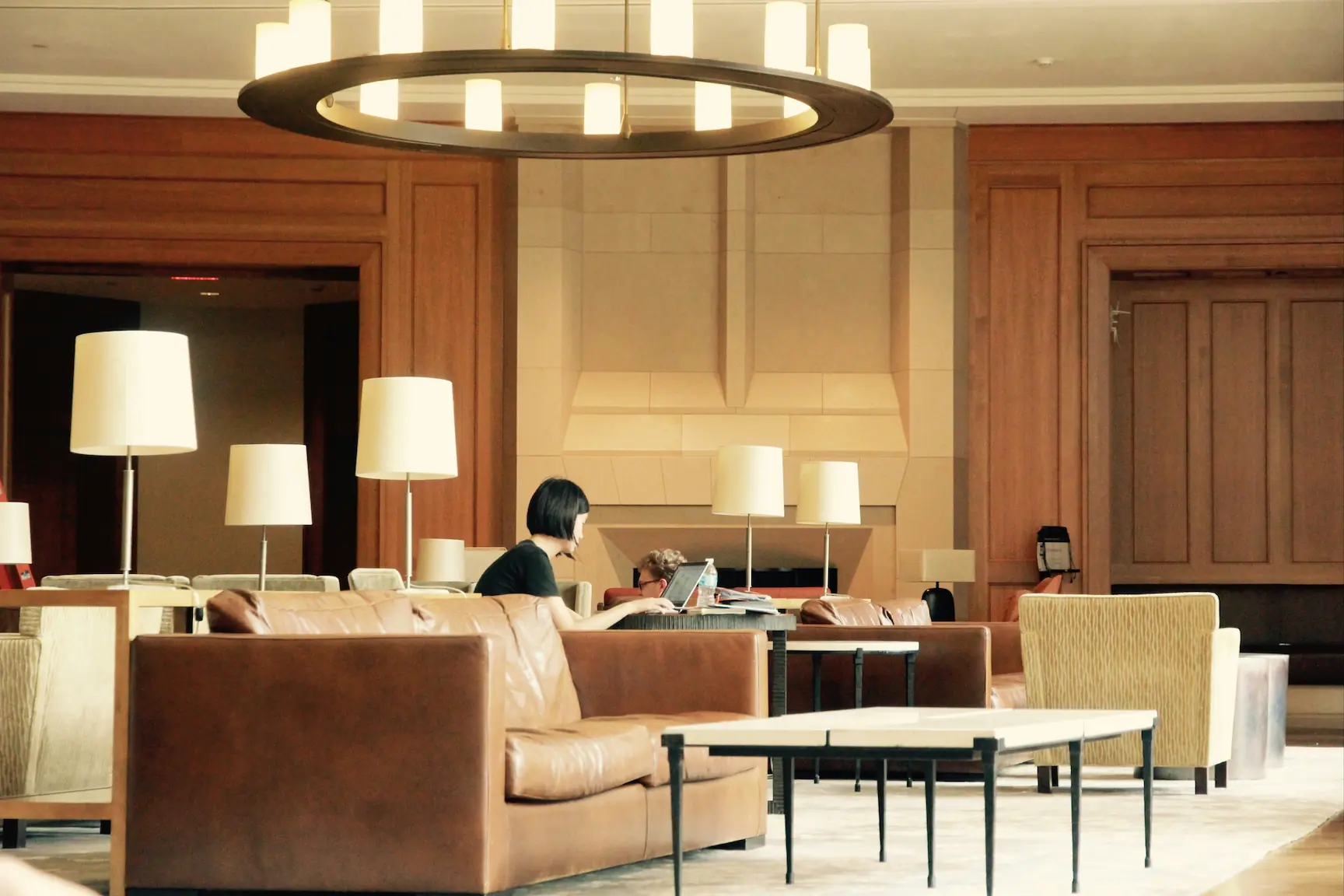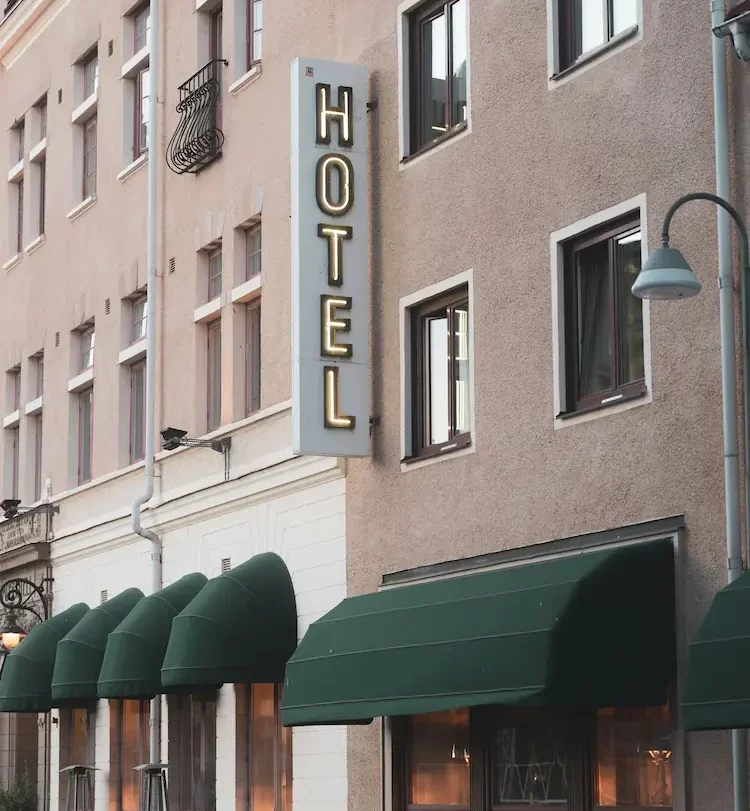How successful brands choose PMS systems
Choosing the right Property Management System (PMS) is a crucial business decision. It's the heart of your business, handling everything from bookings to invoicing and analyses. Make the right choice and your business will run smoothly.
The problem? There are several PMS solutions on the market today. All claim to be the best choice. Some have attractive prices but lack key features. Others have powerful tools but require months of training.
This guide explains how successful companies choose their PMS systems. We look at real-life cases, review key features and show you how to avoid costly mistakes.
Once you've finished reading, you'll know exactly how to choose the best PMS system for your business - one that not only meets your current needs, but also helps you grow in the future.
Let's start by understanding what a PMS actually is and why it is so important to your success.
What is a PMS system for hotels?
- Manage booking processes.
- Managing payments.
- Managing guest communication.
- Streamlines cleaning tasks, customer service and administration.
- Supports data analysis and decision-making.
Types of PMS systems
There are two main types of PMS systems: locally installed and cloud-based. Both have their own benefits and challenges, and which one is best suited depends on your organisation's needs.
Locally installed PMS
An on-premises PMS is installed directly on the company's own computers. It provides greater control over data and customisation options. It is a good solution for companies with specific security requirements or unique work processes. For example, companies in regions with strict data laws may prefer a localised installation.
The downside is the high initial cost of both equipment and licences. In addition, the system requires continuous maintenance and often an IT department. This can be a challenge for smaller businesses with limited resources.
However, a major advantage is that the system can be tailored to the needs of the business, making it a good choice for established companies that want full control over their infrastructure.
Cloud-based PMS
Cloud-based PMS systems are becoming increasingly common, especially in fast-growing industries. Their popularity is due to their flexibility and cost-effectiveness. As everything is managed online, there is no need for expensive hardware or in-house IT staff.
One of the main advantages is ease of integration. Many cloud-based systems can be connected to external platforms such as Online Travel Agencies (OTAs), making the workflow more automated.
Although the initial cost is low, monthly subscription fees can become a significant expense over time. But for many businesses, the benefits - such as automatic updates and minimal maintenance responsibilities - outweigh the cost.
For businesses committed to growth, cloud-based systems offer unrivalled scalability.
Want to know more about how these schemes affect the hotel industry? Read our article on PMS automation.
- Requires physical servers and local IT infrastructure.
- High initial investment costs for hardware and installation.
- Restricted access - can only be used on site.
- Updates and maintenance must be handled manually by IT staff.
- Security risks as older systems often lack modern safeguards.
- Often difficult to integrate with other systems, creating inefficient workflows.
- Data is at risk of being lost in case of server failure without a proper backup solution.
- Scaling up is costly and requires additional hardware investments.
- Limited backup and recovery options, increasing the risk of data loss in the event of a system crash.
- Slower pace of innovation - more difficult to implement new features and updates compared to cloud-based systems.
- Accessible from any device with an internet connection.
- Lower initial costs - usually subscription-based solutions.
- Automatic updates and security upgrades without downtime.
- High security with encryption, GDPR compliance and real-time backups.
- Easy to integrate with other systems such as CRM, booking engines and payment solutions.
- Scalable - hotels can easily add more rooms, locations or features if needed.
- Real-time data and analytics for better business decisions and optimised revenue management.
- Reduced need for local IT staff and technical maintenance.
- Faster implementation and shorter learning curve for staff.
Before we get into how to choose the right PMS system, it might be helpful to understand the basics. If you are new to the field or want to refresh your knowledge, you can read our guide on PMS systems. Already got it covered? Then let's move straight on to how to find the best system for your business.
Key features to look for in a PMS system
When choosing a Property Management System (PMS), it is important to compare the features to find a system that matches your needs.
1. User-friendly interface
A simple and intuitive interface is crucial. It makes the system easy to use and reduces training time for staff. The faster they learn the system, the more time they can spend on their tasks.
2. Opportunities for integration
A PMS should be able to integrate with existing systems, such as financial and CRM systems. This will allow different departments to work together more smoothly and data to flow seamlessly between systems.
3. Powerful reporting tools
Good reporting capabilities provide insights into business performance, which is crucial for making informed decisions and improving operations.
To help you choose the right system, we have developed some key criteria:
- User experience and interface
- Integration and compatibility
- Performance and reliability
- Cost comparison
- Learning curve
- Customer support
WBE PMS Self-service Dialogue Analyses POS
All online bookings are managed in the same platform as the PMS. A single true source for your data.
A powerful platform that combines your PMS, WBE, POS, CRM and channel manager. All systems and data in one place.
Checking in and out, making payments, updating information, adding extra services. Everything is easily managed by the guest.
Improve your guest communication. Information, reminders, suggestions for extra services and marketing. All easily automated in our powerful communication suite.
Reporting tools with great flexibility to create the reports and statistics you need.
Payments on site, online payments. Card, Swish, bank transfer, Apple Pay, etc. All included.
A platform.
For all systems.
Online booking in your PMS.
All online bookings are managed in the same platform as the PMS. A single true source for your data.
All in one place.
A powerful platform that combines your PMS, WBE, POS, CRM and channel manager. All systems and data in one place.
Let the guests help themselves.
Checking in and out, making payments, updating information, adding extra services. Everything is easily managed by the guest.
Communication that engages.
Improve your guest communication. Information, reminders, suggestions for extra services and marketing. All easily automated in our powerful communication suite.
Get insights from your data.
Reporting tools with great flexibility to create the reports and statistics you need.
All types of payments.
Payments on site, online payments. Card, Swish, bank transfer, Apple Pay, etc. All included.
Advantages of using a PMS system
- Simplifies daily tasks
- Increases team efficiency
Streamlining operations
A PMS reduces manual tasks by automating bookings, billing and check-ins. By automating these steps, hotels can save both time and resources. For example, a task that used to require several people can now be handled with a few clicks.
The system also synchronises schedules in real time, so housekeeping and bookings are always up to date. This reduces the risk of double bookings and other mistakes.
Increases staff productivity
The automation of routine tasks allows staff to focus more on guest service. When they are freed from repetitive tasks, they can put more energy into creating a better guest experience. This leads not only to more satisfied guests, but also to higher staff satisfaction.
By spending more time with guests, staff can build stronger relationships, often leading to repeat bookings and positive reviews.
Improves decision-making
With real-time reports and analyses, management can quickly identify trends and make better decisions. For example, insights on occupancy can help plan staffing more effectively. Similarly, data on profitable customer segments can be used for targeted marketing campaigns.
By analysing competition and guest behaviour, hotels can adjust their prices in real time to maximise revenue without compromising profitability.
Facilitates compliance with rules and laws
A PMS helps businesses comply with industry standards and laws by automating and documenting necessary processes. It ensures that accounting and payments are handled correctly and that guest data is managed according to applicable data protection laws.
Many systems also offer updates that automatically adapt to new regulations, keeping your organisation ahead of the game in terms of compliance.
Making it easier to grow
With a PMS system, it's easy to scale up your business. It adapts to growing needs and makes it easy to add more rooms or services without affecting performance. Cloud-based systems in particular offer great flexibility and require minimal IT support.
By having a system that grows with the business, companies can plan for expansion without compromising on service quality.
8 tips for choosing the right PMS
Choose a cloud-based PMS for better scalability, remote access and automatic updates.
Ensure that the PMS has seamless integration with OTAs and direct booking engines to maximise occupancy.
Look for dynamic pricing tools that adjust prices based on demand, season and competitor prices. Often this is an integration to an external platform.
Choose a PMS with CRM features to track guest preferences and increase repeat bookings.
A mobile-friendly PMS allows staff to manage operations from anywhere, increasing efficiency.
Advanced reporting tools help you track revenue, occupancy trends and profitability in real time.
Secure and smooth payment processing speeds up transactions and reduces the risk of errors.
Automate task distribution and get real-time updates to improve turnaround times.
Comparison of PMS options for businesses
Choosing the right Property Management System (PMS) is crucial. Here we go through the main factors to consider.
Pricing and value
Pricing for Property Management Systems (PMS) varies depending on the provider and the features included. Many systems use a monthly fee, which means a fixed cost to access the system, regardless of the number of users or properties. However, for businesses with larger needs, additional costs may apply. Per-user surcharges are common, meaning that the price increases as more staff gain access to the system. Similarly, if your business has multiple properties, such as hotels, campsites or hostels, a per-site surcharge may apply.
Some providers base their pricing on the size of the accommodation facility, using a monthly cost per room. This means that a hotel with more rooms will pay more, which can be an advantage for smaller operations but a cost challenge for larger establishments. Other systems use a revenue-based model, where the cost is calculated as a percentage charge on all booking revenue processed through the PMS system. A similar model applies to bookings made via the web-based booking engine (WBE), where a percentage fee is charged on bookings received via the hotel's own website.
Beyond basic costs, extra features may incur additional charges. Many PMS providers offer a channel manager to synchronise bookings with different distribution channels, but this may come at a separate cost. For each connected OTA (Online Travel Agency), such as Booking.com or Expedia, there may be an additional charge per integrated OTA, which means that costs can quickly increase for businesses that rely on many different booking channels.
For businesses that want more advanced features, there may also be fees for specific services. For example, automation, revenue management and AI-driven pricing may be features that require an additional monthly fee. Similarly, some systems charge to integrate with external services such as CRM systems, POS (point of sale) systems or accounting software.
Payment processing is another area where costs may be incurred. Many PMSes have a transaction fee on payments, where the system charges a fixed fee plus a percentage of the amount on all transactions processed online. If POS systems and payment terminals are included in the PMS solution, an additional point-of-sale (POS) fee may apply, as well as a separate charge for physical payments via POS and terminals.
Finally, there are also costs for communicating with guests. A common example is a fee for text messaging, where each message sent from the system - such as booking confirmations or reminders - incurs a cost. This can be an important factor to consider for hotels that use automated communication extensively.
In conclusion, the pricing models of PMS providers can be complex, and it is important to carefully analyse the different cost components. Some schemes offer more transparent and fixed pricing, while others may seem cheap at the outset but quickly become expensive when all the extras are factored in. Understanding and comparing these fees is crucial to choosing a PMS solution that fits your organisation's budget and needs.
How to choose the best PMS system
- Steps to match PMS with business objectives.
- Ensure that the choice meets specific needs.
Step 1: Assess the needs of the business
Start by understanding your business in detail. Identify problem areas that affect daily operations. List the specific requirements that the system must fulfil. If check-in takes too long, make it a priority requirement.
Also review legal requirements and operational bottlenecks. Is data protection a challenge? Does data entry take too much time? The better the understanding, the easier the choice of PMS will be.
To make sure you don't miss anything, put together a selection group with representatives from different departments, such as IT, finance and operations. A broader view makes for a more informed decision.
Industry standards
A good PMS should comply with current rules and standards, especially in the field of data protection. A system that automatically adapts to new rules saves time and energy.
Step 2: Shortlist and test options
Once the needs are clear, you can start to weed out systems that do not match the requirements. Focus on those that seem to have the most potential.
Book demonstrations with suppliers and test the systems in practice. Take note of ease of use and functionality. Ask questions and ask for concrete examples of how the system can improve your organisation.
Get input from the team that will use the system. Their insights can be crucial and help to identify both advantages and disadvantages.
Step 3: Make a data-driven decision
Collect all feedback from the tests and analyse the results. Both qualitative judgements and quantitative data, such as cost and effectiveness, should be taken into account.
Compare the strengths and weaknesses of the systems by creating an overview. This will give you a clearer picture of what is best for your organisation.
Use a scoring method to evaluate factors such as cost, ease of use and functionality. The system with the highest score should be the best choice.
Other considerations
Before making the decision, check the provider's technical support. Is support available around the clock? Is training offered for users? A good support package can be crucial for a smooth transition.
Gather all the decision makers and review all the data collected before finalising the choice. Unity within the team increases the chances of a successful implementation.
Think about the future too. Choose a system that can grow with your business. That way, you won't have to change systems in the middle of a growth phase, saving both time and resources.
10 pitfalls to avoid when choosing PMS.
Ensure that the PMS integrates seamlessly with your existing systems (e.g. CRM, accounting, booking platforms).
Ensure that the PMS integrates seamlessly with your existing systems (e.g. CRM, accounting, booking platforms).
Ensure that the PMS integrates seamlessly with your existing systems (e.g. CRM, accounting, booking platforms).
Ensure that the PMS integrates seamlessly with your existing systems (e.g. CRM, accounting, booking platforms).
Ensure that the PMS integrates seamlessly with your existing systems (e.g. CRM, accounting, booking platforms).
Ensure that the PMS integrates seamlessly with your existing systems (e.g. CRM, accounting, booking platforms).
Ensure that the PMS integrates seamlessly with your existing systems (e.g. CRM, accounting, booking platforms).
Ensure that the PMS integrates seamlessly with your existing systems (e.g. CRM, accounting, booking platforms).
Ensure that the PMS integrates seamlessly with your existing systems (e.g. CRM, accounting, booking platforms).
Delays and crashes can negatively impact both the guest experience and daily operations.
Common mistakes when choosing a PMS system
- Avoid common pitfalls to choose the right system.
- Involve staff to improve the efficiency of the system.
- Prepare for future growth without extra costs.
1. Ignoring staff input
Ignoring the views of staff is like ignoring the foundation of the building. They use the system daily and can identify potential problems. Including them in the decision-making process increases acceptance, improving both usability and workflow.
A broad selection group with representatives from all departments ensures that the PMS meets everyone's needs. Talk to reception, housekeeping, finance and management to get the full picture.
2. Ignoring long-term goals
Many companies change PMS systems after only a few years due to a lack of future planning. A system should be able to scale up, adapt to new markets and integrate with future tools.
Choosing a system that cannot grow with your business can lead to expensive replacements later on.
3. Focusing only on cost
Price is important, but cheapest is not always best. Lower costs may mean fewer features, poorer support or limited scalability, which can lead to higher operating costs in the long run.
Evaluate the long-term value of the system, including efficiency and automation. A balance between price and functionality often gives the best result.
4. Underestimating integration and support
A PMS must be able to integrate with existing systems to avoid isolating information. If systems do not work together, it can result in more manual labour and less efficiency.
Support is equally important. Many people only realise the need for support when problems arise. Make sure your provider offers sufficient support and training.
5. Not evaluating performance and ease of use
Not testing the system properly can lead to unwanted surprises. Organise demonstrations and pilot projects to ensure that the system works smoothly and meets your requirements.
Make sure that everyone who will use the system gets to try it out before decisions are made.
Summary
Choosing the right Property Management System (PMS) is a strategic decision that affects the entire business - from booking management and operations to guest experience and business growth. A well-thought-out PMS solution can streamline daily processes, reduce manual tasks and create better collaboration between different systems and departments. However, a poorly thought-out choice can lead to costly mistakes, inefficient operations and limited scalability.
One of the most important factors in choosing a PMS is to identify the needs of the business today and what is required to grow in the future. A system that is adapted to current operations but lacks scalability may become a limitation in the future. Therefore, it is crucial to choose a PMS that can integrate with other systems, handle increased volumes and adapt to changing requirements.
In order to make an informed choice, it is important not only to focus on price, but also to consider functionality, integrations, ease of use and support. Cheap systems may appear attractive on the surface, but may involve hidden costs for additional features, integrations and poor customer support. A transparent pricing system and a supplier with good support can save both time and money in the long run.
Furthermore, organisations should ensure that the PMS system has user-friendly interfaces and a smooth learning curve for staff. A complicated system requires lengthy training and can lead to more mistakes in daily operations. Simplicity, clear workflows and mobile-friendly solutions can improve efficiency and reduce the need for technical support.
Finally, it is important to test the system before purchase. By booking demos, conducting pilot projects and gathering feedback from staff, the organisation can ensure that the system meets both short-term and long-term needs. Including representatives from different departments in the decision-making process ensures that the PMS works smoothly for everyone who will use it.
In summary, the choice of PMS should be based on a clear needs analysis, careful evaluation of features and an understanding of how the system can contribute to the development of the business. A well-considered choice can create better workflows, higher efficiency and an improved guest experience - ultimately leading to increased profitability and long-term success. The next step? Draw up a list of requirements, book demos and evaluate the options carefully - the PMS of the future is what will best support your business growth.







